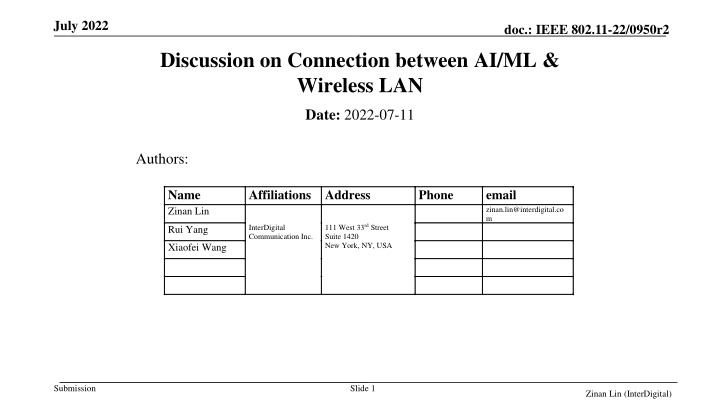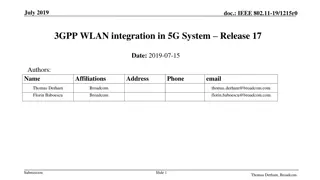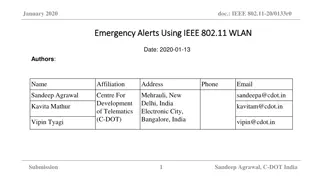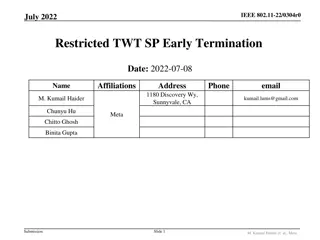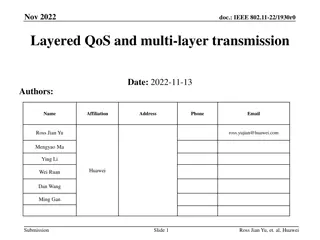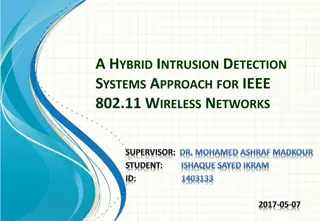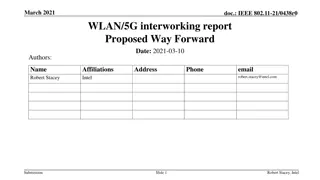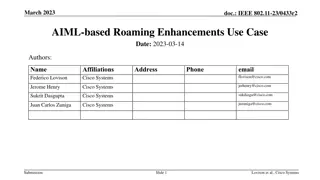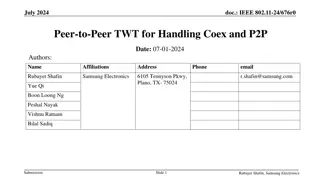AI/ML Integration in IEEE 802.11 WLAN: Enhancements & Optimization
Discussing the connection between Artificial Intelligence (AI)/Machine Learning (ML) and Wireless LAN networks, this document explores how AI/ML can improve IEEE 802.11 features, enhance Wi-Fi performance through optimized data sharing, and enable network slicing for diverse application requirements. Use cases include AI/ML applications on access points (APs) and non-AP stations (STAs) for features like CSI feedback enhancement, single link optimization, access optimization, and multi-link optimization.
Uploaded on Nov 23, 2024 | 2 Views
Download Presentation

Please find below an Image/Link to download the presentation.
The content on the website is provided AS IS for your information and personal use only. It may not be sold, licensed, or shared on other websites without obtaining consent from the author.If you encounter any issues during the download, it is possible that the publisher has removed the file from their server.
You are allowed to download the files provided on this website for personal or commercial use, subject to the condition that they are used lawfully. All files are the property of their respective owners.
The content on the website is provided AS IS for your information and personal use only. It may not be sold, licensed, or shared on other websites without obtaining consent from the author.
E N D
Presentation Transcript
July 2022 doc.: IEEE 802.11-22/0950r2 Discussion on Connection between AI/ML & Wireless LAN Date: 2022-07-11 Authors: Name Zinan Lin Affiliations Address InterDigital Communication Inc. Phone email zinan.lin@interdigital.co m 111 West 33rd Street Suite 1420 New York, NY, USA Rui Yang Xiaofei Wang Submission Slide 1 Zinan Lin (InterDigital)
July 2022 doc.: IEEE 802.11-22/0950r2 Abstract In this contribution, we discuss how Artificial Intelligence (AI)/Machine Learning (ML) can connect with WLANs Submission Slide 2 Zinan Lin (InterDigital)
July 2022 doc.: IEEE 802.11-22/0950r2 Introduction AI/ML has been extensively studied in academia and industry and found its way into many different scientific fields [1], [2] 3GPP Release 18 will study AI/ML for NR air interface to enhance performance or reduce complexity/overhead [3] The 802.11 specifications have been regularly updated with more demanding requirements and new features Next generation of Wi-Fi may require higher throughput (>100 Gbps [4], > 2x 11be [5]), lower latency (<=1ms [4] ), extra reliability (> 99.999999% [6], [7], [8]) Multiple generations of Wi-Fi network with different applications need to co-exist efficiently How can AI/ML connect with 802.11? Submission Slide 3 Zinan Lin (InterDigital)
July 2022 doc.: IEEE 802.11-22/0950r2 Study Topics of Connection Between AI/ML and WLAN Different topics about AI/ML vs WLAN have been extensively studied and summarized in [1] [2] [9] The main topic areas include Topic 1: Using AI/ML to improve IEEE 802.11 features Better one specific feature or jointly optimize multiple features across layers [1] [2] Optimize the use of WM resources for individual BSS s, ESS s, and multiple BSS/ESS interactions Topic 2: Creating a communication efficient wireless network to facilitate AI/ML implementation 802.11 protocol may need to be updated to facilitate the data sharing (Distributed ML) or model parameters sharing (Federated Learning) between AP(s) and non-AP STAs [9] Topic 3: Deploying AI/ML enabled structure to optimize 802.11 network slicing Network slicing in 802.11 networks - meet the diverse set of requirements for multiple applications under a flexible infrastructure [10] Submission Slide 4 Zinan Lin (InterDigital)
July 2022 doc.: IEEE 802.11-22/0950r2 AI/ML Enhanced Wi-Fi Features - AI/ML on AP and Non-AP STAs Use cases: CSI feedback enhancement [1], [11], [12] AI/ML technology can be used for the enhancements of different CSI feedback types More details will be discussed later Single link optimization [1] Rate selection (MCS, MIMO mode and BW) monitoring the service time ratio of an A-MPDU, improved SNR prediction Access optimization CW optimization reducing both collisions and idle time periods to maximize the throughput [1] Multi-link optimization Traffic distribution among different links, e.g., 5 GHz and 6 GHz [1] Machine Learning AP STA1 Machine Learning STA3 Machine Learning STA2 Machine Learning In above use cases, AP and Non-AP STAs may perform the AI/ML algorithm independently Submission Slide 5 Zinan Lin (InterDigital)
July 2022 doc.: IEEE 802.11-22/0950r2 AI/ML Enhanced Wi-Fi Features - Study Scope Use case: Identify a list of use cases (e.g., one or two) as the preliminary study of AI/ML enhancement of Wi-Fi features Framework: Unify the structure of AI/ML implementation AP side only or all STAs or non-AP STAs only KPI metric: Define an KPI metric or KPI metrics to evaluate an AI/ML enhanced WiFi feature Different WiFi features may need different KPI metrics AI/ML algorithm types: Select one AI/ML algorithm type (e.g., supervised, unsupervised or reinforcement learning) to compare different proposals An AI/ML algorithm may need to be implemented among different STAs to get fair access to the channel, e.g., CW optimization Submission Slide 6 Zinan Lin (InterDigital)
July 2022 doc.: IEEE 802.11-22/0950r2 One Example of AI/ML Enhanced WLAN Features - CSI Feedback Enhancement CSI feedback enhancement, e.g., overhead reduction, improved accuracy/prediction, has been identified as one of the initial AI/ML study cases in 3GPP Release 18 [3] ML/AI enabled CSI feedback in Wi-Fi: One potential solution is to use an index-based CSI [11]or compressed CSI feedback scheme [12] via real time or offline training Reduced overhead may lead to higher sensitivity to the CSI accuracy Possible standardization area: Uniform CSI compression algorithm Singling candidate CSI vector set Submission Slide 7 Zinan Lin (InterDigital)
July 2022 doc.: IEEE 802.11-22/0950r2 Example of AI/ML Enabled Index Based CSI Feedback Scheme - Intelligent Feedback Overhead Reduction (iFOR) via Online Learning [11] Broadcast Nk candidate vectors Machine Learning Machine Learning Clustering algorithm Index-based CSI feedback Database Legacy CSI feedback AP AP Legacy CSI feedback Nk candidate vectors Legacy CSI feedback STA1 STA1 STA3 STA3 STA2 STA2 Phase 2: Index-based CSI Reporting Phase Phase 1: CSI ML Training Phase Phase 1 CSI ML Training Phase: Algorithms such as K-means clustering enable choosing a set of ?? number of candidate CSI feedback vectors, each of which contains index values of quantized {? ?} and {? ? } per subcarrier group Phase 2 Index-based CSI Reporting Phase: Non-AP STA only needs to report the index of the selected vector among the candidate vector set after AP distributes the CSI candidate vector set Submission Slide 8 Zinan Lin (InterDigital)
July 2022 doc.: IEEE 802.11-22/0950r2 Example of AI/ML Enabled Index Based CSI Feedback Scheme - Intelligent Feedback Overhead Reduction (iFOR) using Offline Training [11] Machine Learning Offline traing Clustering algorithm Nk candidate vectors Offline Database AP Broadcast Nk candidate vectors Index-based CSI feedback STA1 STA3 STA2 CSI Offline Training: Algorithms such as K-means clustering enable choosing a set of ?? number of candidate CSI feedback vectors, each of which contains index values of quantized {? ?} and {? ? } per subcarrier group; AP broadcasts Nk candidate vectors to associated non-AP STAs. Index-based CSI Reporting: Non-AP STA only needs to report the index of the selected vector among the candidate vector set Submission Slide 9 Zinan Lin (InterDigital)
July 2022 doc.: IEEE 802.11-22/0950r2 Summary and Way Forward Discuss the possible study topics on how AI/ML interacts with WLAN Focus on the topic on how AI/ML improves Wi-Fi features List multiple uses cases of AI/ML enhanced Wi-Fi features Discuss the potential impact on 802.11 specs Present CSI feedback reduction as one example of AI/ML enhanced feature and illustrate the framework of AI/ML deployed in WLAN to reduce CSI feedback Way forward Identify the list of use cases Unify the simulation baseline and reference model Define the evaluation metric(s) Submission Slide 10 Zinan Lin (InterDigital)
July 2022 doc.: IEEE 802.11-22/0950r2 References [1] S. Szott, K. Kosek-Szott, P. Gaw owicz, J. T. G mez, B. Bellalta, A. Zubow, F. Dressler, WiFi Meets ML: A Survey on Improving IEEE 802.11 Performance with Machine Learning , IEEE Communications Surveys & Tutorials [2] M. Kulin, T. Kazaz, I. Moerman, E. de Poorter, A Survey on Machine Learning-Based Performance Improvement of Wireless Networks: PHY, MAC and Network Layer, Electronics. 2021; 10(3):318. [3] 3GPP TR, 38.843, Study on AI/ML for NR air interface [4] 11-22/0030, Look ahead to next generation [5] 11-22/0032, Next Gen After 11be [6] 11-22/0694, Thoughts on Next Gen WLAN [7] 11-22/0729, 802.11 GEN8 Study Group [8] 11-22/0708, Beyond be Proposed Next Step [9] H. Hellstr m, J. M. B. Silva Jr., M. M. Amiri, M. Chen, V. Fodor. H. Vincent Poor and C. Fischione, Wireless for Machine Learning: a Survey https://arxiv.org/pdf/2008.13492.pdf [10] S. d. Bast, R. Torrea-Duran, A. Chiumento, So. Pollin, H. Gacanin, Deep Reinforcement Learning for Dynamic Network Slicing in IEEE 802.11 Networks , IEEE Inforcom, April 2019 [11] M. Deshmukh, Z. Lin, H. Lou, M. Kamel, R. Yang, I. G ven , Intelligent Feedback Overhead Reduction (iFOR) in Wi-Fi 7 and Beyond, in Proceedings of 2022 VTC-Spring [12] P. K. Sangdeh, H. Pirayesh, A. Mobiny, H. Zeng, LB-SciFi:Online Learning-Based Channel Feedback for MU-MIMO in Wireless LANs, in Proceedings of 2020 IEEE 28th ICNP Submission Slide 11 Zinan Lin (InterDigital)
